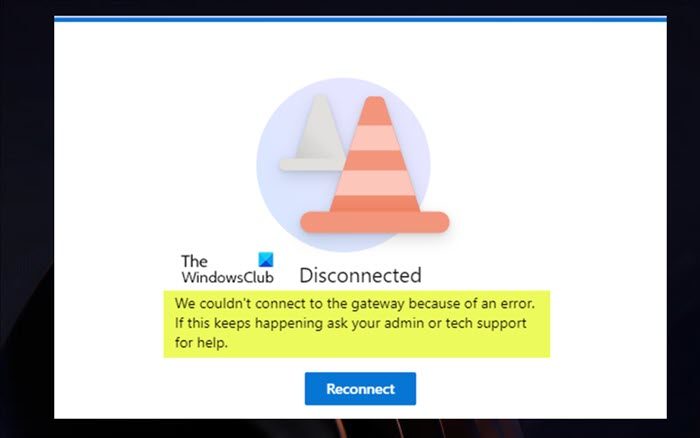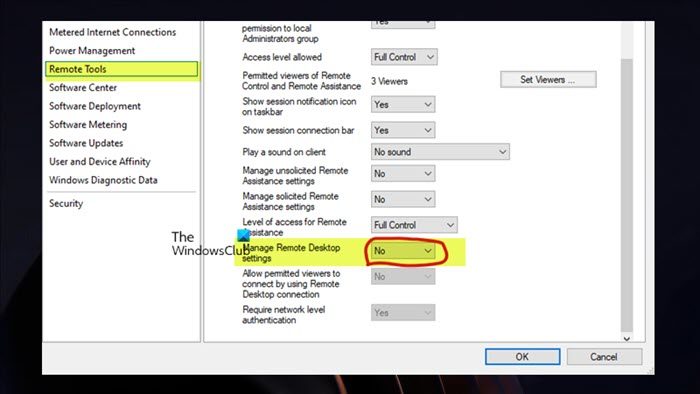When trying to launch the Cloud PC from the Windows 365 portal at windows365.microsoft.com (web client) or via the RDP client, the end-user may get the We couldn’t connect to the gateway error message. This post provides the most suitable fixes that can be applied to resolve the issue.

Reportedly, the problem occurs whether the user is trying to connect from either Windows or macOS device. The full error message reads as follows:
We couldn’t connect to the gateway because of an error. If this keeps happening, ask your admin or tech support for help.
The Cloud PC user receives this error message after entering the username and password for the second time. In another scenario, the user account can see the virtual desktop in the web browser but when trying to connect, the connection fails while opening the remote port. In addition, trying to connect through the app, the user is unable to due to insufficient or no permission. However, the user can remote into the virtual desktop but cannot access the virtual desktop with the admin account that was used to join the virtual desktop.
Using the remote desktop client, the following error message and code are displayed; similar to the Remote Desktop Error Code 0x3000046 on Windows computers.
An error occurred while accessing this resource. Retry the connection or contact your system administrator.
Error code: 0x3000047
Fix We couldn’t connect to the gateway error on Cloud PC
If the error message We couldn’t connect to the gateway is shown when an end-user tries to launch and sign into the Cloud PC, then the suggestions we have provided below in no particular should help resolve the issue.
- Check for licensing issues
- Check for browser-related issues
- Check the Windows 365 Cloud PC watchdog (the connection status)
- Check for Windows 365 Cloud PC User Connectivity errors
- Make sure the deployed servers are in the AADDC Computers OU
- Reprovision the Windows 365 Cloud PC
- Raise the user password complexity
- Check the Remote Tools settings in ConfigMgr
Let’s see these suggestions in brief detail.
1] Check for licensing issues
Reportedly, We couldn’t connect to the gateway error that users may encounter on the Cloud PC has to do with licensing. In a known case, the solution that worked was to start an Azure P2 trial for the tenant. So, if an IT admin, you need to find out exactly what license is required for the end-users, as maybe a cheaper license would suffice.
Read: How to set up Remote Help
2] Check for browser-related issues
You can troubleshoot this error and see if it’s browser-related by performing the following actions:
- Use another browser
- Try using incognito mode
- Use different browser profiles
- Clear the browser cache
- Try using the guest user profiles in the browser
- Try to log in to the Windows 365 Cloud PC from a different Windows 11/10 machine
3] Check the Windows 365 Cloud PC watchdog (the connection status)
If you’re an admin, you can troubleshoot the issue by checking the Windows 365 Cloud PC watchdog (the connection status) from the following location in the MEM Admin center portal.
- Login to the MEM Admin Center Portal at endpoint.microsoft.com.
- Navigate to Devices > Windows 365 > Azure Network Connection tab.
- Select the network connection used by the problematic Cloud PC.
- Click on the Overview page to check the status of the connectivity.
If everything looks OK from the connection side, then you can check the Microsoft Admin portal for any ongoing Windows 365 Cloud PC service issues.
4] Check for Windows 365 Cloud PC User Connectivity errors
For this, you can check for Windows 365 Cloud PC User Connectivity Errors from the MEM Admin center portal where all the connectivity errors for the Cloud PC users are listed by following these steps:
- Open the MEM Admin center portal.
- Navigate to Devices > Windows 365 > All Cloud PC tab.
- Click on the Cloud PC that you want to check the user connectivity error report.
- Scroll down and click on the User Connectivity tab to check the Cloud PC Connectivity error report.
If everything looks OK and nothing points to the issue, then you can proceed with the next suggestion.
Read: Windows 365 Cloud PC Setup & Known Issues with Fixes
5] Make sure the deployed servers are in the AADDC Computers OU
This fix also worked in the case where you’re using Azure Active Directory Domain Services, you need to make sure the deployed servers are in the AADDC Computers OU. For users that need to log in, they can log in using an account that is in the AADDC Users OU. In addition, make sure the admin user is a member of the AADDC Administrators group in Azure Active Directory. Once this is done, users can finally be able to Remote Desktop directly into the deployed VMs in the host group.
6] Reprovision the Windows 365 Cloud PC
You can reprovision the Windows 365 Cloud PC and see if that helps. This will be a fairly easy procedure because of Windows 365’s orchestration engine. To perform this task, follow these steps:
- Open the MEM Admin center portal.
- Navigate to Devices > Windows 365 > All Cloud PC tab.
- Click on the Cloud PC that is showing the error.
- Click on the Reprovision (Remote Actions) button.
- Click on the Yes button to confirm.
Once the Cloud PC reprovisioning is completed, the Reprovision: Completed message will be displayed. The user should now be able to log in to the Cloud PC normally without the error.
7] Raise the user password complexity
Changing or raising the user password complexity might solve the problem as it did in some other cases. You can raise the password complexity as follows:
- Minimum length 12 characters.
- Capital letters of European languages (A to Z, with diacritics, Greek and Cyrillic characters).
- Lowercase letters from European languages (a to z, sharp-s, with diacritics, Greek and Cyrillic characters).
- Figures in base 10 (0 to 9).
- Non-alphanumeric characters (special characters) can include (~! @ # $% ^ & * _- + = ‘| \ () {} \ []:; »» <>,.? /) currency symbols such as l Euro or a British pound are not considered special characters for this policy setting.
- The password should not be in a dictionary (dictionary attack).
- The password should not be a subject known as Christmas, Easter, Carnival, etc.
8] Check the Remote Tools settings in ConfigMgr

For this fix to the issue, you need to check the Remote Tools > Manage remote desktop settings in the ConfigMgr policy. This requires that the Manage remote desktop settings policy is set to No if you are running Co-Management. Once done, end-users should be able to access the Cloud PC without issues.
Hopefully, this helps!
Read next: Remote Desktop Gateway server is temporarily unavailable
We couldn’t verify your gateway connection status because the connection timed out?
If you have Dell Secure Connect Gateway (SCG) installed on a single Hyper-V VM, when you go to the SMTP settings to test connectivity on the email server on the on-premises Exchange Server, it may fail this error message even though it sends you emails. In addition, the SCG connectivity status is green on the web page. These connection issues could impact your ability to monitor devices and automatically create support cases. This issue appears to be with the test since you receive the email, so the function is working. However, make sure SCG is updated to the latest version.
What does it mean when you can’t contact the gateway?
This error indicates that the application in use can see the address of the gateway but is unable to communicate or connect with it. This issue usually occurs due to local network connectivity problems because one or more of the links in your local network may malfunction, be saturated by traffic, or have low signal strength. As a quick fix, you can reboot the gateway by unplugging it for a few seconds and then plugging it back in, then wait a minute or two and try to update the status in the app once more manually.